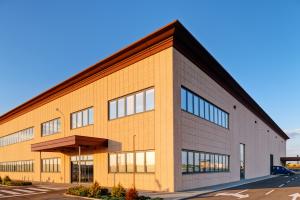Renovation Ready: When It’s Time to Upgrade a Facility Instead of Building New
A well-built structure doesn’t always need to be replaced...If the foundation, framing, and core systems remain strong, the smarter move is often to renew what already exists”
SLIDELL, LA, UNITED STATES, October 29, 2025 /EINPresswire.com/ -- Across Southeast Louisiana, businesses and property owners are increasingly reevaluating how to expand or modernize their facilities. The decision between new construction and renovation often depends on cost, location, and long-term functionality. In many cases, renovating an existing structure provides a practical alternative that preserves investment value while adapting to current needs.— Jules Albert III
At Jaymar Construction LLC in Slidell, Louisiana, years of field experience have shown that renovation projects, when approached strategically, can deliver efficiency and renewed performance without the cost or disruption of starting from the ground up. According to Jules Albert III, owner of the company, knowing when a building is ready for renovation begins with understanding its bones. “A well-built structure doesn’t always need to be replaced,” Albert explained. “If the foundation, framing, and core systems remain strong, the smarter move is often to renew what already exists.”
Evaluating the Existing Structure
Every facility reaches a point where maintenance and operational demands outpace its original design. Aging mechanical systems, outdated layouts, and changing safety codes eventually require major intervention. The first step is a structural evaluation.
In Southeast Louisiana, environmental conditions play a large role in determining whether renovation is feasible. High humidity, shifting soil, and seasonal storms can wear down exterior materials and compromise foundations. However, many commercial and industrial structures in the region were built with reinforced concrete or steel frames—materials that age well with proper maintenance.
A structural engineer’s assessment provides clarity about which components remain sound and which require replacement. If the core framing, foundation, and roof structure are intact, renovation becomes a viable path forward.
Cost Considerations
New construction often carries higher upfront expenses than renovation. Site preparation, permitting, and infrastructure installation all add significant cost before vertical work even begins. Renovation projects, by contrast, can often leverage existing utilities, foundations, and access points.
That said, renovation costs vary depending on the complexity of the project and the extent of hidden damage. Electrical, plumbing, and HVAC systems in older buildings may require full upgrades to meet current code standards. Factoring in contingencies for these updates ensures financial stability throughout the process.
A careful cost analysis should compare not only the immediate price of renovation versus new construction but also long-term operational efficiency. Retrofitting energy-efficient lighting, HVAC, and insulation during renovation can reduce utility expenses and improve sustainability without the higher cost of starting new.
Zoning, Permits, and Local Regulation
Zoning and permitting play a critical role in determining whether renovation is more practical than building new. In many Louisiana parishes, zoning restrictions or space limitations prevent expansion beyond an existing footprint. Renovation allows adaptation within those boundaries while maintaining compliance.
Historic districts and waterfront properties, in particular, often face additional regulations. In these cases, modifying an existing structure can provide a path forward that honors local design standards while meeting modern performance needs.
Permitting timelines also tend to be shorter for renovations, as many projects qualify as improvements rather than new development. This advantage reduces downtime and allows faster occupancy once work is complete.
Functional Modernization
Facilities designed decades ago often reflect work habits and equipment that no longer exist. Renovation provides an opportunity to reconfigure layouts, improve workflow, and integrate technology.
In manufacturing and commercial settings, open floor plans can replace segmented rooms to accommodate larger equipment or collaborative workspaces. In office buildings, modern renovations often focus on improving natural light, sound insulation, and air circulation—all factors that enhance productivity and comfort.
Technology upgrades are another key aspect. Updating wiring, data cabling, and energy systems ensures compatibility with modern automation and digital infrastructure. Even simple improvements like LED lighting and motion sensors can dramatically improve energy efficiency while reducing maintenance demands.
Sustainability and Environmental Responsibility
Sustainability has become an important factor in facility planning. Renovating an existing building minimizes environmental impact by reducing the waste and energy consumption associated with demolition and new material production.
Reusing materials such as structural steel, masonry, or concrete not only preserves embodied energy but also reduces transportation emissions. Integrating green building practices—such as low-VOC finishes, water-efficient fixtures, and advanced insulation—creates healthier indoor environments while reducing operational costs.
In coastal Louisiana, where environmental preservation is an ongoing concern, sustainable renovation aligns with community priorities and long-term resilience goals.
Minimizing Disruption to Operations
One of the biggest advantages of renovation over new construction is the ability to phase work around ongoing operations. Many commercial and industrial projects can be completed in stages, allowing sections of a facility to remain functional while upgrades occur elsewhere.
This phased approach requires precise planning and coordination but reduces overall downtime. Employees and tenants can continue working without full relocation, saving both time and logistical expense.
Scheduling construction during off-peak hours, weekends, or slower business periods further minimizes disruption. For organizations that rely on continuous operation, this flexibility can be the deciding factor in choosing renovation over replacement.
Preserving Community and Identity
In Louisiana, buildings often hold cultural and historical value beyond their physical use. Many commercial properties have stood through generations of business and community change. Renovation allows these landmarks to evolve without losing their identity.
Modernizing older structures maintains the connection between past and present while extending the lifespan of properties that define local character. It also supports economic stability by revitalizing established business districts instead of relocating them.
For growing communities across St. Tammany Parish, Slidell, and the Northshore region, facility renovation provides a practical path toward progress without sacrificing familiarity.
Knowing When to Renovate
Not every building is a candidate for renovation, but many that appear outdated still possess strong potential. When structural integrity remains sound, and when the site continues to serve a strategic purpose, renovation offers a balanced approach between modernization and preservation.
The key lies in early evaluation. Thorough inspection, accurate budgeting, and clear communication between engineers, architects, and contractors ensure that all options are considered before major decisions are made.
A well-planned renovation not only updates the physical space but also revitalizes its purpose. Whether it’s a commercial facility, office complex, or manufacturing site, upgrading an existing structure often provides a more efficient, environmentally responsible, and financially sustainable solution than starting anew.
About Jaymar Construction LLC
Jaymar Construction LLC, based in Slidell, Louisiana, provides professional construction and renovation services for commercial, industrial, and residential projects across Southeast Louisiana. Led by Jules Albert III, the company is committed to precision craftsmanship, transparent project management, and long-term structural integrity for every build.
Morgan Thomas
Rhino Digital, LLC
+1 504-875-5036
email us here
Visit us on social media:
Facebook
Legal Disclaimer:
EIN Presswire provides this news content "as is" without warranty of any kind. We do not accept any responsibility or liability for the accuracy, content, images, videos, licenses, completeness, legality, or reliability of the information contained in this article. If you have any complaints or copyright issues related to this article, kindly contact the author above.


